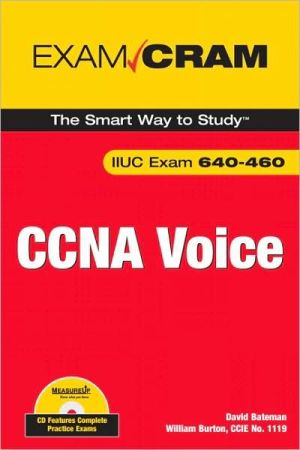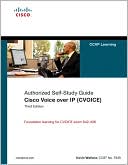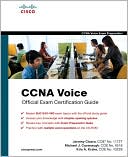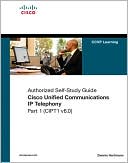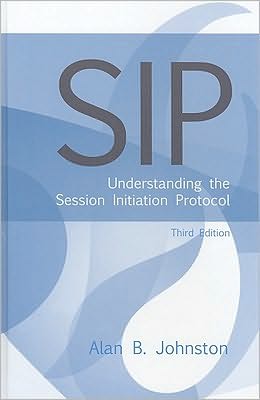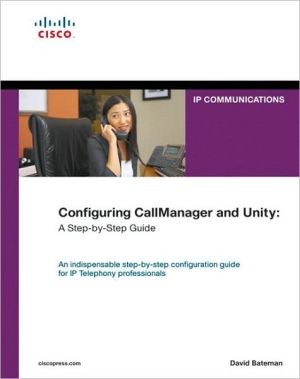CCNA Voice Exam Cram (Exam Cram Series)
CCNA Voice Exam Cram\ \ IIUC Exam 640-460\ \ David Bateman\ William Burton, CCIE No. 1119\ \ In this book you’ll learn how to\ \ Understand digital and analog circuits\ Use voice signaling protocols\ Connect your VoIP system to the rest of the world\ Configure your network to support VoIP\ Configure QoS and Cisco AutoQoS\ Configure Cisco Unified CME to support endpoints and connect to a service provider\ Configure Cisco Unity Express\ Implement business features\ Maintain...
Search in google:
CCNA Voice Exam Cram IIUC Exam 640-460 David Bateman William Burton, CCIE No. 1119 In this book you’ll learn how to Understand digital and analog circuits Use voice signaling protocols Connect your VoIP system to the rest of the world Configure your network to support VoIP Configure QoS and Cisco AutoQoS Configure Cisco Unified CME to support endpoints and connect to a service provider Configure Cisco Unity Express Implement business features Maintain and troubleshoot Cisco Unified CME and Cisco Unity Express Implement the Smart Business Communications System WRITTEN BY LEADING EXPERTs: David Bateman is a certified Cisco instructor with more than 20 years of internetworking experience. David is currently the director of curriculum development for Skyline-ATS. William Burton, CCIE No. 1119, CCVP, CCNP, CCVA, CCNA, is an author, instructor, and IT implementer with more than 35 years of experience. Mr. Burton’s experience includes small to global network architecture and deployments for federal agencies, state and local governments, corporations, and educational institutions. CD Features Test Engine Powered by MeasureUp! This book includes a CD-ROM that features Complete coverage of CCNA Voice exam objectives Practice exams with detailed explanations of correct and incorrect answers Multiple exam modes An electronic copy of the book informit.com/examcram ISBN-13: 978-0-7897-3799-1 ISBN-10: 0-7897-3799-X
Introduction Self Assessment Part I: Traditional Telephony CHAPTER 1:Traditional Telephony Overview Understanding the Legacy PSTN Business Phone Systems Call Signaling Supervisory Signaling Addressing Informational PSTN Call Setup Numbering Plans E.164 Addressing Exam Prep Questions Answers to Exam Prep Questions CHAPTER 2:Introducing Analog Circuits Analog Telephone Components Foreign Exchange Trunks Foreign Exchange Station Foreign Exchange Office Understanding Circuit Types Loop Start Ground Start E&M Exam Prep Questions Answers to Exam Prep Questions Suggested Reading and Resources CHAPTER 3: Introducing Digital Circuits From Analog to Digital: Coder/Decoder (Codec) Revealed Sampling Quantization Encoding Quantized Values to Binary Compression Introducing TDM Understanding Circuit Types T1 Circuits E1 Circuits Understanding Signaling Types Channel-Associated Signaling (CAS) CCS Summary Exam Prep Questions Answers to Exam Prep Questions Suggested Reading and Resources Part II:VoIP CHAPTER 4: Voice to VoIP Introducing Digital Signal Processors Understanding Transport Protocols Real-Time Transport Protocol Real-Time Transport Control Protocol Packetizing Voice Streams G.711 Codec G.729 Codec Understanding Codecs Comparing G.729 and G.729a Codecs Understanding the Effect of VAD Additional DSP Functions Echo Cancellation Conferencing Transcoding and Media Termination Point Exam Prep Questions Answers to Exam Prep Questions Suggested Reading and Resources CHAPTER 5: Functions of VoIP Signaling Protocols SCCP H.323 MGCP SIP Exam Prep Questions Answers to Exam Prep Questions Suggested Reading and Resources CHAPTER 6: Connecting Your VoIP System to the Rest of the World Understanding Gateways Analog Gateways and Voice Ports Digital Gateways and Voice Ports Digital Gateways Understanding Call Legs Understanding Dial Peers Dial Peer Overview POTS Dial Peers VoIP Dial Peers Dial Peer Commands Matching Dial Peers Using Internet Telephony Service Providers Exam Prep Questions Answers to Exam Prep Questions Suggested Reading and Resources CHAPTER 7: Configuring the Network to Support VoIP Understanding the Theory of Voice VLANs Configuring Voice VLANs VLANs and an External Router Router with Built-in Switch Ports Power over Ethernet Essential Network Services: DHCP and NTP DHCP Services DHCP Relay Service Network Time Protocol Understanding the Phone Bootup Process Installing Cisco IP Phone Firmware and XML Configuration Files Firmware Device Configuration XML File Default XML File Exam Prep Questions Answers to Exam Prep Questions Suggested Reading and Resources CHAPTER 8: Reviewing QoS and Configuring the Cisco AutoQoS Feature Defining QoS Why Converged Networks Need QoS Networks Before Convergence Networks After Convergence Measurable QoS Issues: Bandwidth, Delay, Loss, and Jitter Bandwidth Capacity End-to-End Delay Packet Loss Variation of Delay: Jitter Techniques to Solve QoS Issues QoS Traffic Tagging for IP and LAN Traffic The IP Header TOS Field The CoS Field for Layer 2 Frames Understanding QoS Traffic Requirements Voice Video Data Building a QoS Policy for Converged Networks Identifying the Network Traffic Divide the Traffic into Service Classes Define Policies for Each Service Class An AutoQoS Primer Trust Boundaries Cisco Devices That Support AutoQoS Exam Prep Questions Answers to Exam Prep Questions Part III: Cisco Unified CME and Unity Express in Business CHAPTER 9: Introducing Cisco Unified CME Understanding the Benefits of Cisco Unified CME Understanding Cisco Unified CME Features Phone Features System Features Trunk Features Voicemail Features Knowing the Hardware and Software Requirements Required Platform Software and Licensing Exploring Supported Endpoints Exam Prep Questions Answers to Exam Prep Questions Suggested Reading and Resources CHAPTER 10: Configuring Cisco Unified CME to Support Endpoints Ephones and Ephone-dns Configuring Ephones Configuring Ephone-dns Configuring Telephony Service Telephony Service Commands Firmware Provisioning Registration Configuration Endpoint Verification Endpoint Reboot Exam Prep Questions Answers to Exam Prep Questions Suggested Reading and Resources CHAPTER 11: Configuring Cisco Unity Express Setting Up Cisco Unity Express Voicemail Cisco Unity Express Platforms and Capacities Cisco Unity Express Features and Functionality Preintegration CLI Configuration Installation and Upgrade Procedure GUI Initialization Wizard Using Cisco Auto Attendant Activating the Auto Attendant Managing Prompts with the GUI and AVT (TUI) Troubleshooting Cisco Unity Express Host Router CLI Tools Exam Prep Questions Answers to Exam Prep Questions CHAPTER 12: Implementing Business Features Configuring Common Features Call Forward Call Transfer Call Park Call Pickup Groups Intercom Configuring Additional Features Paging MOH Directory Services Call Blocking Call Accounting Exam Prep Questions Answers to Exam Prep Questions Suggested Reading and Resources CHAPTER 13: Maintaining and Troubleshooting Cisco Unified CME Backup and Restore Troubleshooting the Cisco Unified CME Installation Initial IP Phone Activation and Registration Issues Common show Commands Used to Verify CUCME Operations Exam Prep Questions Answers to Exam Prep Questions Part IV: Cisco Smart Business Communications System CHAPTER 14: Introducing the Smart Business Communications System SBCS Overview Cisco Unified Communications 500 Series Platform Catalyst Express Switches Supported Endpoints Using Additional SBCS Features SBCS Wireless Features SBCS Security Features Understanding the Cisco Configuration Assistant Exam Prep Questions Answers to Exam Prep Questions Suggested Reading and Resources CHAPTER 15: Implementing the Smart Business Communications System Installing CCA and Managing the SBCS Setup Device Properties Graphical Views Upgrading File Management Cisco Configuration Assistant: Voice Configuration Device System Network Auto Attendant and Voicemail SIP Trunk Voice Features Dial Plan Users Cisco Configuration Assistant: System Configuration Configure Port Settings Configure Security Configure Wireless Configure Routing Monitoring SBCS with CCA View the Health of a Cisco Smart Business Communications System Review and Respond to Cisco Smart Business Communications System Events Review and Respond to Cisco Smart Business Communications System Messages Maintaining SBCS with CCA Software Upgrade Back Up and Restore Device Configurations Reset a Cisco Smart Business Communications System to a Factory Default State Exam Prep Questions Answers to Exam Prep Questions Part V: Practice Exams and Answers CHAPTER 16: Practice Exam 1 CHAPTER 17: Practice Exam 1 Answer Key CHAPTER 18: Practice Exam 2 CHAPTER 19: Practice Exam 2 Answer Key Part VI: Appendixes Appendix A: Cisco Unified Communications Overview Appendix B: What’s on the CD-ROM Glossary 078973799x TOC 12/19/2008
